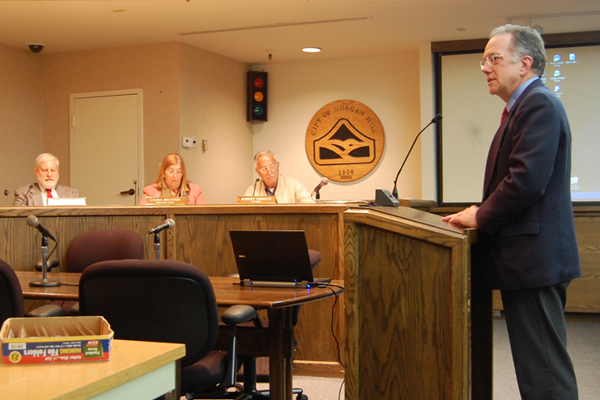
A study of two proposed locations for a high-speed rail station
in Gilroy will address concerns of traffic circulation, parking,
land use, economic impacts and other factors, a city official said
during a South County Joint Planning Advisory Committee meeting
Thursday night in Morgan Hill.
A study of two proposed locations for a high-speed rail station in Gilroy will address concerns of traffic circulation, parking, land use, economic impacts and other factors, a city official said during a South County Joint Planning Advisory Committee meeting last week in Morgan Hill.
David Bischoff, Gilroy director of planning and environmental services, told the committee the study would also focus on the pros and cons of three different track alignments: at-grade, aerial and trenched.
The study, which is funded by a $150,000 matching grant from the Valley Transportation Authority, will go before the Gilroy City Council, which then will send a station recommendation to the rail authority based on the knowledge gained from the study, Bischoff said.
The city has yet to hire a consultant to prepare the study.
The California High-Speed Rail Authority has designated two possible locations for a station in Gilroy – downtown and east of Highway 101 just outside the city. The CHSRA will make its decision later this fall, Bischoff said.
Several residents who attended Thursday’s meeting, however, said the east Gilroy station shouldn’t be an option.
Yvonne Sheets-Saucedo read a statement from Californians Advocating Responsible Rail Design claiming the east Gilroy station violated an existing 20-year agreement between Santa Clara County’s Local Agency Formation Commission, the city of Gilroy and the Santa Clara County Board of Supervisors.
According to the statement, the east Gilroy station would fall within a protected area, as described in the “Strategies to Balance Planned Growth and Agricultural Viability” which was approved Gilroy, LAFCO and the county supervisors in the fall of 2006.
“The proposed east Gilroy station would be in the northernmost part of the protected area in the unincorporated part of Santa Clara County,” Sheets-Saucedo read. “The alignment would bisect this protected area and would include a station with commensurate parking and other structures with the intent of creating a very dense area around the station.”
The document should be reviewed before any study takes place, according to the statement. The statement also claims the east station proposal was not studied in the program environmental impact report for the CHSRA’s San Jose to Merced corridor.
District 1 Supervisor Mike Wasserman said the county’s “legal eagles” had already started looking at whether the station would violate the agreement and expected the issue to be resolved within one to two weeks.
“It wasn’t a known issue before,” Wasserman said.
He added, “We’ll be hearing from the attorneys shortly.”
Bischoff said if the east station was picked as the preferred site, the city still would need to draft an amendment to its general plan to allow it.
Gilroy City Administrator Tom Haglund wrote Sunday in an e-mail that the LAFCO document was not a type of contractual agreement.
“At this point there is no basis to say that conducting the city’s grant-funded east side visioning process requires the city to first revisit the strategy document as suggested by CARRD, nor is there reason for the previously awarded VTA grant funds to be withheld from the city,” Haglund wrote.
Jennifer Williams, executive director for the Santa Clara County Farm Bureau, said Thursday that land east of Gilroy was “the best remaining farmland,” and constructing a rail station in that region was “counter to everything in society we’re trying to protect.”
Julie Hutcheson, an advocate for the Committee for Green Foothills, said she feared an east Gilroy station would contribute to a loss of agriculture, due to the station footprint and the tracks themselves.








